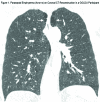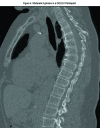Visual Assessment of CT Findings in Smokers With Nonobstructed Spirometric Abnormalities in The COPDGene® Study
- PMID: 25197723
- PMCID: PMC4153727
- DOI: 10.15326/jcopdf.1.1.2013.0001#sthash.L0atdpjM.dpuf
Visual Assessment of CT Findings in Smokers With Nonobstructed Spirometric Abnormalities in The COPDGene® Study
Abstract
Within the COPD Genetic Epidemiology (COPDGene®) study population of cigarette smokers, 9% were found to be unclassifiable by the Global Initiative for chronic Obstructive Lung Disease (GOLD) criteria. This study was to identify the differences in computed tomography (CT) findings between this nonobstructed (GOLDU) group and a control group of smokers with normal lung function. This research was approved by the institutional review board of each institution. CT images of 400 participants in the COPDGene® study (200 GOLDU, 200 smokers with normal lung function) were retrospectively evaluated in a blinded fashion. Visual CT assessment included lobar analysis of emphysema (type, extent), presence of paraseptal emphysema, airway wall thickening, expiratory air trapping, centrilobular nodules, atelectasis, non-fibrotic and fibrotic interstitial lung disease (ILD), pleural thickening, diaphragmatic eventration, vertebral body changes and internal thoracic diameters (in mm). Univariate comparisons of groups for each CT parameter and multiple logistic regression were performed to determine the imaging features associated with GOLDU. When compared with the control group, GOLDU participants had a significantly higher prevalence of unilateral diaphragm eventration (30% vs. 16%), airway wall thickening, centrilobular nodules, reticular abnormality, paraseptal emphysema (33% vs. 17%), linear atelectasis (60% vs. 35.6%), kyphosis (12% vs. 4%), and a smaller internal transverse thoracic diameter (255 ± 22.5 [standard deviation] vs. 264.8 ± 22.4, mm) (all p<0.05). With multiple logistic regression, all of these CT parameters, except non-fibrotic ILD and kyphosis, remained significantly associated with GOLDU status (p<0.05). In cigarette smokers, chest wall abnormalities and parenchymal lung disease, which contribute to restrictive physiologic impairment, are associated with GOLD-nonobstructed status.
Keywords: classification; computed tomography; lung diseases; obstructive.
References
-
- Respirology; Global Initiative for Chronic Obstructive Lung Disease strategy for the diagnosis, management and prevention of chronic obstructive pulmonary disease: an Asia-Pacific perspective. Respirology. 2005;10(1):9-17. doi: http://dx.doi.org/10.1111/j.1440-1843.2005.00692.x - PMC - PubMed
-
- Iqbal A,Schloss S,George D,Isonaka S. Worldwide guidelines for chronic obstructive pulmonary disease: a comparison of diagnosis and treatment recommendations. Respirology. 2002;7(3):233-239. doi: http://dx.doi.org/10.1046/j.1440-1843.2002.00399.x - PubMed
-
- Celli BR,MacNee W. Standards for the diagnosis and treatment of patients with COPD: a summary of the ATS/ERS position paper. Eur Respir J. 2004;23(6):932-946. doi: http://dx.doi.org/10.1183/09031936.04.00014304 - PubMed
-
- Kohler D,Fischer J,Raschke F,Schonhofer B. Usefulness of GOLD classification of COPD severity. Thorax. 2003;58(9):825. doi: http://dx.doi.org/10.1136/thorax.58.9.825 - PMC - PubMed
-
- Arne M,Lisspers K,Stallberg B,et al. How often is diagnosis of COPD confirmed with spirometry? . Respir Med . 2010;104(4):550-556. doi: http://dx.doi.org/10.1016/j.rmed.2009.10.023 - PubMed
Grants and funding
LinkOut - more resources
Full Text Sources




